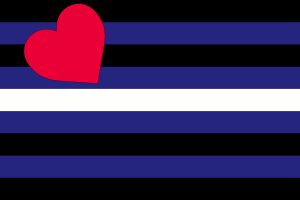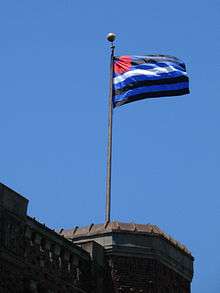Leather Pride flag

| LGBT symbols |
|---|
| Flags |
| Other symbols |
The Leather Pride Flag is a symbol used by the leather subculture since the 1990s. It was designed by Tony DeBlase in 1989, and was quickly embraced by the gay Leather community. It has since become associated with Leather in general and also with related groups.
History

The flag was designed by Tony DeBlase (who lived 1942-2000). He first presented the design at the International Mister Leather event in Chicago, Illinois, U.S. on May 28, 1989.[1]
Initial reaction to the flag was mixed. According to DeBlase's article A Leather Pride Flag,
"Some, particularly on the east coast, reacted positively to the concept, but were quite concerned, some even offended, that I had not involved the community in helping to create the design."[2]
In June of 1989 the flag was used by the leather contingent in a Portland, Oregon pride parade, which was its first appearance at a pride parade.[3]
On September 18, 1990, Clive Platman (Mr. Australia Drummer) presented Tony DeBlase with an Australian version of the flag, incorporating the southern cross, which is from the Australian national flag, with the original design of the leather pride flag.[3]
On October 11, 1991, at the opening ceremonies of Living in Leather, a Canadian version of the leather pride flag was presented, which added to the original flag's design a row of red maple leaves running horizontally through the white stripe.[3]
Also in 1991, Melbourne Leather Men became the first club to incorporate the design elements of the leather pride flag into their club colors.[3]
On December 12, 2000, NLA Florida presented a suggested pledge of allegiance to the leather pride flag at its holiday party in Fort Lauderdale, which reads, “I pledge allegiance to the Leather Pride flag, and the union of Leather people for which it stands, with safety, sanity and consent for all.”[3]
The San Francisco South of Market Leather History Alley consists of four works of art along Ringold Alley honoring leather culture; it opened in 2017.[4][5] The four works of art are: engraved standing stones that honor community leather institutions including the Folsom Street Fair and leather pride flag pavement markings through which the stones emerge, a black granite stone etched with a narrative by Gayle Rubin, an image of the "Leather David" statue by Mike Caffee, and with a reproduction of Chuck Arnett’s mural in a former leather bar, and metal bootprints along the curb which honor 28 people who were an important part of the leather communities of San Francisco.[5]
The original flag is on display at the Leather Archives and Museum.
Design
Creator DeBlase gave this explanation of the design:
"The flag is composed of nine horizontal stripes of equal width. From the top and from the bottom, the stripes alternate black and royal blue. The central stripe is white. In the upper left quadrant of the flag is a large red heart. I will leave it to the viewer to interpret the colors and symbols."[6]
Popularity

Although the flag is common in the gay leather community, it is not an exclusively gay symbol and represents the entire leather community.
Furthermore, while designed as a symbol for the leather subculture, it is also widely used within the BDSM (bondage & discipline, dominance and submission, sadomasochism) subculture.
Variations
Although DeBlase is quoted as saying the design is copyrighted in the U.S. (as well as all countries where the Berne Convention standards apply), copyright is automatic, and need not be obtained through official registration with any government office. Once an idea has been produced as a tangible form, for example by securing it in a fixed medium (such as a drawing, sheet music, photograph, a videotape, or a computer file), the copyright holder is entitled to enforce their exclusive rights.
Various groups have adapted the design and sold it commercially or used it to represent different organizations or campaigns. The BDSM rights flag, for example, is intended to represent the belief that people whose sexuality or relationship preferences include BDSM practices deserve the same human rights as everyone else, and should not be discriminated against for pursuing BDSM with consenting adults.[7] Leather & Grace, an organization of Unitarian Universalist kinksters, combined a red flaming chalice with the stripes of the Leather Pride flag for their logo.[8]
See also
- Bisexual pride flag
- Folsom Street Fair
- Rainbow flag
- Rubber pride flag
References
- ↑ "Leather History Timeline". Archived from the original on 2010-08-03. Retrieved 2008-02-14.
- ↑ "A Leather Pride Flag". leatherarchives.com. Archived from the original on 2008-09-15.
- 1 2 3 4 5 "Timeline". Web.archive.org. Retrieved 2018-06-24.
- ↑ http://www.artandarchitecture-sf.com/ringold-alleys-leather-memoir.html
- 1 2 Paull, Laura. "Honoring gay leather culture with art installation in SoMa alleyway – J". Jweekly.com. Retrieved 2018-06-23.
- ↑ "The Leather Pride Flag". Retrieved 2018-02-16.
- ↑ "Informed Consent: BDSM rights flag". Archived from the original on 2013-05-02.
- ↑ "Leather & Grace: L&G's Story".
